Die Verweigerung des amerikanischen Traums (Teil 3)
Five Easy Pieces (1970, Regie: Bob Rafelson) Der Filmtitel ist raffiniert, weil er sehr offen wirkt und weil es sein kann, dass man sich am Ende des Films an keine Stelle erinnern kann, in der von „five easy pieces“ die Rede ist; man könnte sich aber an eine Schlüsselszene erinnern, in der diese Worte sinngemäß fielen oder gefallen sein könnten. Es gibt mehrere Filmcover, von denen ich zwei hier untereinander einfüge, auch wenn das nicht so super aussieht. Wenn man die Bilder zusammensetzt, ergeben sie eine ziemlich genaue, aber doch vage Ahnung vom Inhalt des Films. (Natürlich gibt es hier keine Inhaltsangabe.)

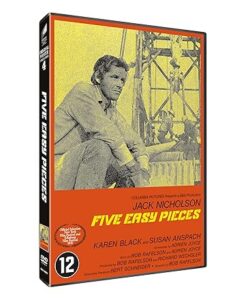
Am Notenblatt ist zu erkennen, dass sich die fünf leichten Stücke auf Musiknoten fürs Klavier beziehen, wobei die Stücke durchaus anspruchsvoll sind. Jack Nicholson vor einem Ölbohrturm und sitzend an einem Klavier, das auf einem Transporter steht. Auf dem dritten Cover (ohne Abbildung) steht: „He rode the fast lane on the road to nowhere.“ In diesem Spannungsfeld bewegt sich der Plot und vor allem die Figur, die Jack Nicholson mit der gewohnt beeindruckenden schauspielerischen Leistung verkörpert.
In der deutschen Fassung wurde der Filmtitel wieder einmal ruiniert. Hier heißt es platt: „Ein Mann sucht sich selbst.“ Es ist vor allem der Charakter der Hauptfigur, die die Handlung bestimmt. An zwei Stellen wird über seine Persönlichkeit reflektiert. Einmal erklärt er sich so: „My life, I mean, most of it, doesn’t add up to much that I could relate as a way of life that you’d approve of. I move around a lot. Not because I’m looking for anything, really, but because I’m getting away from things that get bad if I stay.“ Sein Gegenüber versteht jedoch nichts von diesem Bekenntnis; es ist sein Vater, von zwei schweren Schlaganfällen gezeichnet. Die zweite Charakterisierung erfährt Dupea von einer Frau, die ihn zwar gerade erst kennengelernt hat, ihn aber nach einigen intensiven Begegnungen zu erkennen meint.
Five Easy Pieces hat auch einen Roadmovieanteil und wie in Two-Lane Blacktop werden Tramper mitgenommen; hier sind es zwei Frauen, die nach Alaska auswandern wollen, weil sie der Meinung sind, sie könnten dort dem Schmutz und dem Konsumterror der USA entkommen. An dieser Stelle des Films hätte man ein paar Minuten kürzen können; das ist überdehnt.
Das Verhalten der Hauptfigur, seine Persönlichkeitsstruktur, das hat etwas Zeitloses, was der Film wunderbar in zeitgemäße Bilder übersetzt. Die Schlussszene an einer Tankstelle im Bundesstaat Washington beendet den Film konsequent, würdevoll und erschütternd. Die nicht gezeigte Fortsetzung, die man erahnt, hallt nach.
Die Verweigerung des amerikanischen Traums (Teil 1)
Ende der 1960er bis Mitte der 1970er Jahre durchlebte das Kino der USA eine Umbruchsphase, und dazu gehörten Filme, die von europäischen Einflüssen wie der Nouvelle vague geprägt waren, und die auch die politisch-gesellschaftliche Stimmung in den USA spürbar machten, darunter den Vietnamkrieg. Einige junge Regisseure erhielten von den Studios die Freiheit, mit ihren eigenen Ideen zu experimentieren, und sie entschieden sich für Figuren, die sich dem amerikanischen Traum vom Erfolg durch konsequentes Erbringen von Leistung verweigerten. Diese Nische wird auch als eine Art US-amerikanisches Autorenkino bezeichnet.

Two-Lane Blacktop (1971; deutscher Titel: Asphaltrennen) von Monte Hellman ist von den Filmen, die ich hier in einer kleinen Serie vorstelle, der mit der umfassendsten Verweigerung. Das fängt schon damit an, dass es gar nicht so einfach ist, zu erklären, worum es geht. Da sind zwei Autos, ein 55er Chevy und ein 1970 Pontiac, deren Fahrer sich ein Wettrennen von West nach Ost liefern; das Ziel wird geradezu unmotiviert und willkürlich dahingeworfen: Washington D.C. Insofern könnte man die Autos auch als Protagonisten des Films ansehen. So wichtig sind diese Autos aber wiederum auch nicht. Die Fahrer liefern sich auch nicht wirklich ein Autorennen, obwohl dem Gewinner die Papiere für den anderen Wagen winken. Sie haben es nicht eilig, sie machen ausgiebige gemeinsame Pausen an Tankstellen und Straßenrestaurants und die Crew des Chevy unterstützt den Fahrer des Pontiac sogar bei einer Panne. Der Film hat keine nennenswerte Story; die Dialoge bringen keine Handlung, wie man sie in einer Geschichte erwarten würde, in Gang. Wie „Easy Rider“ zeigt „Two-Lane-Blacktop“ atemberaubende Landschaften, Wolkenformationen und Horizonte; insofern fungiert die Landschaft als Protagonist. Der größte Teil des Filmes spielt sich, wie bei einer sehr guten Kurzgeschichte, unterhalb der Oberfläche ab, so wie bei einem Eisberg der größte Teil der Masse unter Wasser liegt. Der Roadtrip ist eine Metapher für das Leben, für ein Lebensgefühl. Dies auf sich wirken zu lassen, ist geradezu meditativ. Am stärksten ist in diesem Film also die Atmosphäre, besonders die Ausstrahlung der drei Personen, die, jedenfalls zeitweise – es ist alles ein bisschen launisch – gemeinsam im Chevy sitzen. Der Fahrer wird dargestellt von dem Sänger James Taylor, sein Mechaniker von Beach Boy Dennis Wilson, und die junge Anhalterin spielt Laurie Bird, über deren Hintergrund Monte Hellman in der Dokumentation, die sich auf der DVD findet, Beeindruckendes erzählt, was zu einer besonderen Tiefe ihrer Persönlichkeit geführt hat. Alle drei sind keine ausgebildeten Schauspieler; es gibt auch zahlreiche Kurzauftritte weiterer, sagen wir: echter Personen wie dem Verkäufer von Autoersatzteilen, jungen Männern einer Gaststätte, Leuten beim Start von Autorennen sowie ganz normalen Menschen an einer Bushaltestelle, die gar nicht wussten, dass hier gedreht wurde, was dem Film einen dokumentarischen Touch verleiht.

Der Fahrer des Pontiac, dargestellt von Warren Oats, nimmt immer wieder Anhalter mit, um ihnen etwas aus dem Leben einer seiner fantasierten Parallelwelten zu erzählen. Einmal steigen eine ältere Frau und ein kleines Mädchen ins Auto ein. In der Dokumentation 34 Jahre nach dem Dreh, erzählt Melissa Hellman, die Tochter des Regisseurs, die im Film das kleine Mädchen spielte, dass sie den Film wahrscheinlich hunderte Mal gesehen hat, und dann drückt sie es so aus: „It sucks me in again, every single time I watch it. I think about things while I was there or about my life now and it’s just all related to each other.“ Das trifft es, auch wenn man nicht bei dem Film mitgespielt hat. Two-Lane-Blacktop handelt von Einsamkeit, von Begegnung, von gemeinsamen Zielen und vom Verlust dieser Ziele, von der Flüchtigkeit der Liebe, von der Schönheit der Natur und der Unberechenbarkeit der Technik. Am Ende reißt einfach der Film, und fängt an, durchzubrennen. Auch das ein Subtext. Two-Lane Blacktop wurde zum Kultfilm der Gegenkultur. Das Drehbuch hat Rudy Wurlitzer geschrieben. Monte Hellman hatte auf Empfehlung von jemandem dessen Roman „Nod“ aus dem Jahr 1968 gelesen, und er sagte darüber, he was really impressed with his kind of wierd, but really brilliant view of the humal condition. So eine Formulierung ist für mich trotz ihrer Schwammigkeit ein klarer Auslöser, in das Buch hineinzulesen. Über diesen Link konnte ich das erste Kapitel von „Nog“ lesen, mich hat die Crazyness begeistert, und habe mir daraufhin das Buch gekauft, ein immer wieder neu veröffentlichtes Kultbuch, das in verschiedenen Coverversionen erschienen ist, zum Beispiel in dieser psychodelischen Variante:
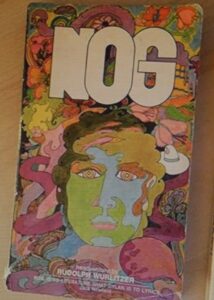
Bruchstück Nr. 7
Eine kleine Weile Aushalten
ich kannte das Empfinden und schlugdie Bücher zu. Sag, sagte ich zu ihr
ein Wort! Und die Türen öffneten sich erneut.
Die Vergangenheit machte wie in den Büchernweiter, eine Form. Ach, wie zart sogar
das Unkraut blüht an manchen sorglosen
Tagen, links von Schwarz und Rotzwischen den Steinen, die keine
Bücher sind, männlich, weiblich, säch
lich, ein Kind, das zärtlich stammelt.Da, an dem Ort, fiel mir die Leere der weißen
Regale auf. Und ich nickte, gut.Während ich mich darauf freue, die nochmals erweiterte Neuausgabe von Rolf Dieter Brinkmanns „Westwärts 1 & 2“ aus der Buchhandlung um die Ecke abzuholen, habe ich das Gedicht auf der Rückseite des Buches, wie es online ist, abgetippt. Das Gedicht (oder ist es ein Auszug aus einem Gedicht?) hat keinen Titel. „Bruchstück Nr. 7“ als Titel dieses Posts würde sich in Rolf Dieter Brinkmanns Methode, Titel für seine Gedichte zu bilden, einfügen. Ah, und einfügen möchte ich hier auch einen Link zu einem Post von mir auf Manafonistas, wo ich vor einigen Jahren einen Zusammenhang von Rolf Dieter Brinkmann zu Jacques Rivette hergestellt habe: Va savoir.
Und man hört sie doch. Die große Feier der Anthologie

Die Präsentation meiner Anthologie „Und man hört sie doch. 20 Jahre Literaturwerkstatt in Darmstadt“ am vergangenen Samstag war überwältigend. Iris Antonia Kogler schrieb mir ein paar Tage vorher: „Es wird wie ein Klassentreffen.“ Es wurde mehr als „wie ein Klassentreffen“, denn es waren nicht nur die Autorinnen und Autoren des Buches dabei, die einander nur teilweise kannten, sondern auch viele andere, die am Seminar teilgenommen hatten, deren Arbeiten ich aber nicht in die Anthologie aufnehmen konnte, und der Abend zog verschiedene Kreise und Zirkel an. Als wir danach noch zu siebt bis Mitternacht im Karagöz saßen, sagte Iris: „Der Satz, den man an diesem Abend am meisten gehört hat, ist der: Kennen wir uns nicht von irgendwoher?“ Etwas schwieriger fand ich die Frage: „Kennst du mich noch?“, die mir einmal gestellt wurde, als ich hinter dem gut bestückten langen Büchertisch stand. Meine Einführungsrede habe ich an meinem Blogbeitrag vom 13. März orientiert, aber auf sieben Minuten begrenzt. Was mir sehr wichtig war: An diesem Abend durch meine Moderationen zwischen den Texten die feinen Verbindungslinien und -bögen in der Reihenfolge herzustellen, wie ich sie ursprünglich geplant hatte, und wie sie im Prozess des Layouts nicht vollständig umgesetzt werden konnte. „Raum und Zeit werden zu Gedankenwelten“, schrieb Helga Köbler-Stählin in ihrer Rezension am 27. März im „Mannheimer Morgen“. Und: „Schön sind sie alle [die Texte, M.W.] geworden: Gefühlvoll, geheimnisvoll, lyrisch, ernst, still und leise.“ Claus Boesser-Ferrari hat uns mit seinem Gitarrenspiel verzaubert. Staunend sah ich ihm zu und lauschte. Es mussten noch Stühle dazugeholt werden. Wie saßen im Tempel der Freimaurerloge, und jeder Text führte uns an einen anderen Ort.

Ploog. West End: Worte & Bilder, die bisher verschüttet waren

Vor zehn Tagen traf ich Wolfgang Rüger im Schiffer Café in Frankfurt Sachsenhausen zur Übergabe des Readers „Ploog. West End: Texte von und über Jürgen Ploog“, erschienen in der Edition W in Neu-Isenburg. Es war eine Kette an glücklichen Zufällen, die dazu führte, dass ich in diesem Buch, das außer von Wolfgang Rüger auch von Jürgen Ploogs Sohn David Ploog herausgegeben wurde, mit einem Text vertreten bin.
Im vergangenen Jahr hatte Herr Rüger über einen längeren Zeitraum in Suchmaschinen verschiedene Begriffe eingegeben, um herauszufinden, was es von und über Jürgen Ploog online gab, und im Spätherbst war mein Text „Navigieren durch den inneren Raum. Ein Beitrag zur Jürgen Ploog-Rezeption“, den ich am 15.08.2023 auf manafonistas gepostet habe, ziemlich weit oben in der Liste und Herrn Rüger gelang es nach einigem Recherchieren, über den Verleger meiner Gedichtbände mit mir Kontakt aufzunehmen. (Der direkte Weg wäre über meinen Eintrag im Autorenlexikon auf literaturport möglich gewesen.) Zu diesem Zeitpunkt war das Manuskript für den Ploog-Reader eigentlich schon abgeschlossen, aber für einen last minute-Beitrag war noch Zeit. Das Konzept des Readers besteht darin, möglichst nur bisher Unveröffentlichtes Material zu versammeln; deshalb sollte ich etwas Neues schreiben. Nach einer Woche schickte ich Herrn Rüger meinen Text mit dem Titel „Allein mit dem eigenen Nervensystem“, der nun im Kapitel „Memories“ gelandet ist. Darin erzähle ich unter anderem davon, wie mein Interview mit Jürgen Ploog, das ich für die Zeitschrift Poet Nr. 21 im Poetenladen Verlag geführt habe und das online hier gelesen werden kann, für einige Zeit eine unerwartete Wendung nahm, was ich in die schriftliche Fassung des Interviews nicht aufgenommen habe, was aber der interessanteste Teil der Begegnung war. Ich schreibe darüber, was mich an Jürgen Ploogs Texten süchtig macht, wie ich mich davon habe inspirieren lassen und schließlich bringe ich noch ein ganz anderes Thema ein, über das noch nie im Zusammenhang mit Jürgen Ploog geschrieben wurde und womit ich mich erst vor etwa einem Jahr beschäftigt habe.
Spaces between spaces. Das Buch hat, ähnlich wie der Sammelband „Ploog. Tanker“ aus dem Jahr 2004, herausgegeben von Florian Vetsch, einen dokumentarischen Charakter und ist eingeteilt in Theorie, Memories, Interviews, Zeitschriften, Briefe, Graphik, Tagebuch, journalistische, programmatische & philosophische Arbeiten, Portraits, Prosa und Nachrufe. Jeder, wirklich jeder Beitrag hat mich berührt und ein Text, eigentlich zwei, ganz besonders. Alles ist authentisch, aufrichtig und ehrlich. Ja, und obwohl ich von Jürgen Ploog fast alles gelesen habe, habe ich noch viel Neues und Überraschendes gesehen und erfahren. Zum Beispiel, wie ihn andere, die ihn nicht aus dem Underground kannten, entdeckten (und was es mit sich brachte): Durch einen Zufallsfund in einem Antiquariat oder im Rahmen einer wissenschaftlichen Arbeit. Bei mir war es ein Plakat auf einer Litfaßsäule mit der Ankündigung einer Lesung und einem großen Portraitfoto. Es war nicht nur die spacige Aura („Katastrophenberichte eines semantischen Raumfahrers“), es war auch der Eindruck der äußeren Erscheinung, der mich vom Fahrrad absteigen ließ. Jürgen Ploog war ausgesprochen fotogen. Das Buch enthält zahlreiche Fotos, die ihn seit Anfang der 70er Jahre in seinem Umfeld zeigen. An einem Imbisstisch mit William S. Burroughs im Berliner Zoo, bei einer Cut-up-Session in mehreren Schnappschüssen in die Tasten einer Schreibmaschine hauend, um einen Wohnzimmertisch sitzend mit jungen Männern und – Frauen? Nein, Anfang der 70er trugen junge Männer langes Haar. Viele Bilder stammen von professionellen Künstlern wie Walter Hartmann, dessen Grafiken den Underground geprägt haben; die Ästhetik und auch die Haptik des Readers ist unglaublich gut.
Im Zentrum stand für Jürgen Ploog immer die Suche nach einem Zustand, den es realiter nicht gibt. Am 5. Mai 2015 schrieb er in sein Tagebuch: „Die nie greifbare Realität des Lebens, einer Existenz. Berühre sie & sie zerfällt, übrig bleiben Fiktionen, Legenden, Formeln, die sich beliebig verändern lassen.“ Und so enthält natürlich auch dieses Buch sehr verschiedene Blickwinkel und widersprüchliche Wahrnehmungen. Mir fiel auf, dass ein paar zentrale Begriffe in unterschiedlichen Texten vorkamen, so dass man Verbindungslinien ziehen könnte. Wie immer im Zusammenhang mit Jürgen Ploog kann man auch in diesem Reader einiges entdecken, was im Dazwischen liegt. „Ich reise in die Sprache, die mir als Medium dient, um Erinnerungsbilder & imaginative Assoziationen aufzuspüren“, heißt es in „Triptik“, einem Text von Jürgen Ploog aus dem Reader. Und: „Das Ziel, das ist mir klar, kann keine Stadt sein, sondern ein Zustand, durch den mein Leben eine andere Richtung nimmt.“
Am 19. Mai 2025 wird das Buch „Ploog. West End“ in der Romanfabrik in Frankfurt vorgestellt. Nach dem Update von Wolfgang Rüger sieht das Programm entgegen anders lautender Ankündigungen im Internet so aus: Wolf Wondratschek wird Texte von Jürgen Ploog vortragen. Dann folgt die Podiumsdiskussion. Auf dem Podium sitzen Ralf-Rainer Rygulla, Klaus Maeck, David Ploog und ich. Geleitet wird die Diskussion von Rainer Weiss. Um 19:30 Uhr geht es los. Open End.
Doppelgänger
„Die New York Trilogie“ war das erste Buch von Paul Auster, das ich gelesen habe, in der zweiten Hälfte der 90er. Gleich der erste Teil, „Stadt aus Glas“, ist eine Story, die jedes auch nur annähernde Gefühl von Gewissheit, Zuversicht und der Möglichkeit von Kontrolle auf faszinierende Weise zerstört. Durchdachtes, systematisches und scheinbar vernünftiges Vorgehen wird ad absurdum geführt. Konturen verschwimmen, so wie das Gespür für den Raum und die Zeit. Auch das Subjekt verschwindet. Im Jahr 1994 erschien „City of Glass“ als Graphic Novel, von Paul Karasik und David Mazzucchelli. Erst jetzt habe ich dieses Buch gelesen bzw. angesehen. Die visuelle Umsetzung ist ein ästhetisches Meisterstück. Sofort lebte ich wieder ganz gebannt in der Welt des Paul Auster, aber auf eine andere Art als gewohnt: in der visuellen Doppelgängerversion. Wer David Mazzucchellis Arbeit kennt, zum Beispiel „Asterios Polyp“ (vor zehn Jahren schrieb ich auf Manafonistas darüber, hier der Link), weiß, dass sie weit darüber hinausgeht, eine Story etwa in einer Aneinanderreihung von Film-Still-Pannels umzusetzen. Das Ziel ist immer, für die Besonderheiten einer Geschichte visuelle Äquivalente zu schaffen und damit weitere Nuancen oder Interpretationsmöglichkeiten hinzuzufügen.
Hier ein paar Beispiele, Details, ohne zu viel zu verraten. Daniel Quinn, die Hauptfigur (jedenfalls ein Name dieser Hauptfigur), sitzt über einen langen, unbestimmten Zeitraum in einem Häuser-Zwischenraum vor dem Haus seiner Auftraggeber, um sie zu beschützen. Die Dauer wird visuell veranschaulicht, indem Quinn mit der Mauer verschmilzt. Dass Quinn an dieser Stelle seinen Verstand verliert und mit einem anderen Blick auf seine Umgebung schaut, zeigt ein verwischtes Pannel.
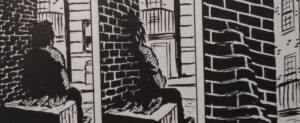
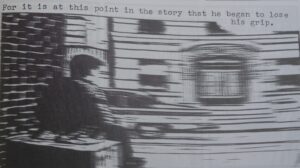
In der zweiten Hälfte des Buches trifft Daniel Quinn den Schriftsteller Paul Auster. Während Paul Auster von seinem aktuellen Buchprojekt erzählt, einem Essay über Don Quixote, und man bei einer filmischen Umsetzung oder einem konventionellen Comic erwarten könnte, dass die Bilder von einem der Männer zum nächsten wechseln, ändern Mazzucchelli und Karasik allmählich raffiniert die Perspektive. Plötzlich sehen wir die Männer beim Lunch als Schattenriss und im Vordergrund einen Teddybär, Baseballhandschuhe und einen Spielzeug-LKW. Es folgt der Blick ans Fenster, dann aus dem Fenster, von verschiedenen Stockwerken aus, und während man den Dialog der Männer weiterliest, fragt man sich gleichzeitig, wohin die Bilderfolge führen mag. Die Perspektive nähert sich schließlich dem Gehweg unten vorm Haus und einem rätselhaften Gegenstand, der dort liegt, dann erkennen wir einen Jojo, den eine Hand ergreift und ein paar Bilder später steht Paul Austers Sohn Daniel im Wohnzimmer und begrüßt den Gast. „City of Glass“ ist durchzogen vom Motiv des Doppelgängers, und Daniel ist sogar ein mehrfacher Doppelgänger.
Die größte Herausforderung war die Umsetzung der Rede eines Mannes, der als Kind neun Jahre lang eingesperrt war. Im Buch beschreibt Paul Auster diese Rede so: „Machine-like, fitful, alternating between slow and rapid gestures, rigid and yet expressive, as if the operation were out of control, not quite corresponding to the will that lay behind it.“ Die sprachlich in gebrochenem Englisch gehaltene Rede wird etwa so illustriert: Die Bilder nähern sich vom Körper zum Gesicht zum Mund, gehen in die Mundhöhle, dann in ein Gewässer, aus dem ein alter Mann mit einem Boot und Ruder auftaucht, der alte Mann führt die Rede fort, die Bilder gehen in seinen Mund, dort taucht eine Art Höhlenzeichnung auf, Formen verschiedener Gegenstände wiederholen sich in den aufeinanderfolgenden Bildern usw. bis zu einer vergitterten Tür und einer gebrochen liegenden Marionette. Immer wieder tauchen in der Graphic Novel Variationen einer Kinderzeichnung auf, die man als Zeichnungen des eingesperrten Jungen interpretieren kann. Über einer dieser Zeichnungen steht eins der Grundprinzipien postmoderner Literatur: „Everything becomes essence: The center of the book shifts, is everywhere…“
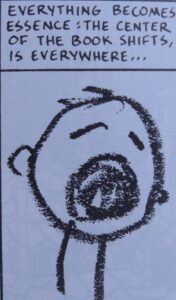
Doppelgänger finden sich auch außerhalb des Buches bzw. der Graphic Novel. Paul Auster ist einer davon. Ein anderer ist ein Schriftsteller, der sich mit grundsätzlichen Umwälzungen der Sprache um 1900 befasste und in eine Schreibkrise geriet: Hugo von Hofmannsthal. Der aus dem Gefängnis entlassene Mr Stillman beschreibt die Ausgangslage in der Graphic Novel so: „When things were whole our words could express them. But things have broken apart, and our words have not adapted.“ Es geht ihm darum, eine angemessene Sprache für die neue Gegenwart zu finden. Hugo von Hofmannsthal beschreibt in seinem Chandos-Brief ein ähnliches, aber anders gelagertes Problem: „Mein Fall ist, in Kürze, dieser: Es ist mir völlig die Fähigkeit abhanden gekommen, über irgend etwas zusammenhängend zu denken oder zu sprechen.“ Für Stillman stellt sich beispielsweise konkret das Problem, dass ein defekter Regenschirm nicht mehr als Regenschirm bezeichnet werden kann; deshalb erfindet er neue Wörter. Das ist sein Buchprojekt. Stillman glaubt also an die Möglichkeit, das Wesen der Dinge in die Sprache der Menschen zu übersetzen. Hugo von Hoffmansthal glaubte das nicht. Im Chandosbrief entwickelt er die Position, dass die Reflexion der Sprache selbst als Element moderner Literatur wesentlich ist.
Am 8. April 2025 erscheinen alle drei Teile von Paul Austers „New York-Trilogie“ als Graphic Novel, umgesetzt von Paul Karasik, Lorenzo Mattotti und David Mazzucchelli.
„Und man hört sie doch. 20 Jahre Literaturwerkstatt in Darmstadt“. Eine Anthologie und was sie bedeutet.

Das Buch ist da, schon einige Wochen ist es her, dass ich drei Pakete mit meinen bestellten Exemplaren bei der Verlegerin, Geraldine Gutiérrez-Wienken, in Heidelberg abgeholt habe. Jedes Buch wird von Hand hergestellt. Maximal zwölf Exemplare schafft sie an einem Tag. Ihre Garage im Hinterhof ist eine Werkstatt. Eine Neonröhre an der Wand beleuchtet die Schneidemaschine. In der Mitte steht dann noch ein anderer, größerer Tisch, für die Falz- und Klebearbeiten. An den Seiten offene Regale mit Kartons: Es wird edles Papier verwendet; nicht zu dünn, es ist griffig. Handarbeit, das bedeutet auch, dass die Seitenränder nicht immer gleich breit sind. Jedes Buch erhält einen Stempel. Mein Exemplar ist ein Probestück vom Dezember, es hat die Nr. 002.
Hinter dieser Anthologie, deren Herausgeberin ich bin, steckt ein Lebensabschnitt. Eigentlich sind es zwei Abschnitte: die Zeit der Seminarleitung, die weitergeht, und die Zeit der Arbeit an dem Buch selbst, die sich über eineinhalb Jahre erstreckte. Es begann am 8. Februar 2005, einem Montag, um 18 Uhr im Literaturhaus in Darmstadt. Alle, die sich dafür interessierten, auch weiterhin an ihren literarischen Texten in einer Gruppe im Diskurs zu arbeiten, saßen an den Tischen im vierten Stock, schrieben ihre Erreichbarkeitsdaten auf Blätter, die jetzt immer noch in einem meiner Ordner zur Literaturwerkstatt eingeheftet sind. Ein Zeitsprung um 20 Jahre: Ungefähr 250 vierstündige Seminare später liegt sie nun vor, die Anthologie, die in dieser Form nur eine Auswahl darstellen kann, Einblicke in die Arbeit von Autorinnen und Autoren, von denen viele im Literaturbetrieb bekannt sind: durch Buch- und Zeitschriftenpublikationen, Preise und Stipendien, Lesungen, Radio- und Fernsehauftritte, Leitungen von Schreibwerkstätten und Herausgeberschaften von Literaturzeitschriften. Ein Buch von vielleicht zweihundert oder gar dreihundert Seiten, mit vollständig abgedruckten Erzählungen, hätte einen anderen Charakter ergeben, den zu präsentieren mich nicht gereizt hat, auch wenn ich deutlich mehr als 27 Autorinnen und Autoren hätte ihren Raum geben können. Ich schätze das Fragmentarische und habe bei der Auswahl der Auszüge aus längeren Texten darauf geachtet, dass sie auch außerhalb ihres Zusammenhangs etwas transportieren. Die Anthologie enthält 15 Gedichte, zwei Kürzestgeschichten, eine Filmszene, einen kurzen Prosatext und 14 Auszüge aus Erzählungen und Romanen. Außerdem selbstverständlich (leider sehr kurze und unvollständige) Kurzbiographien. Um das Ausmaß der Auswahl zu verdeutlichen: In jedem Seminar haben durchschnittlich zwei Personen Texte im Umfang von je 12 Seiten vorgestellt, über die wir dann diskutiert haben, das sind 24 Seiten pro Seminar. Multipliziere ich diese 24 Seiten mit der Zahl der Seminare (250), komme ich auf 6000 Seiten besprochener Literatur.
Es ist nicht nur ein Seminar, an dem im Lauf der Zeit mehr als 100 Autorinnen und Autoren teilgenommen haben, viele davon länger als zehn Jahre; es ist eine Gemeinschaft geworden. Freundschaften sind entstanden, Netzwerke, die weit über die Teilnahme am Seminar hinausgehen. Die Begegnung in dem, was zu einem zentralen Bestand der eigenen Persönlichkeit gehört, verbindet. Bei den Gesprächen über die Texte vergessen wir die Zeit. Immer wieder diskutierten wir, vor allem in meiner zweiten Seminargruppe, der Dienstagsgruppe, statt planmäßig bis 22 Uhr eine halbe Stunde länger und manches Mal wurde es sogar noch später. Dann gingen wir ein paar hundert Meter die Kasinostraße runter, zum „Nazar“, einem türkischen Restaurant, das zwar nicht 24 Stunden offen hatte, aber immerhin 23. Die Atmosphäre war entspannt; wahrscheinlich lag es an den Öffnungszeiten, die verändern das Zeitgefühl. Wir saßen auf Hochsitzen, die Rucksäcke und Taschen zu unseren Füßen, bestellten warme Gerichte, ein „Nachtessen“ im wörtlichen Sinn, und wir ließen uns kurz vor unserem Aufbruch noch kleine Tassen schwarzen türkischen Tees als Geschenk des Hauses servieren, was sich nach Mitternacht wie eine Droge anfühlte, fast ein bisschen illegal, ein Aufputschmittel, das wir für den Rückweg in die verschiedenen Städte, aus denen wir anreisten, manche mehrere hunderte Kilometer weit, brauchten, und das uns länger als erwünscht wachhielt. Ich erinnere mich an einen Teilnehmer, der aus einer kleinen Stadt im östlichen Bayern anreiste. Er fuhr gegen Mittag mit einem Flixbus los, um gegen 18 Uhr in Darmstadt zu sein, nach dem Seminar und dem gemeinsamen Essengehen fuhr er mit mir im Auto mit nach Frankfurt, ich setzte ihn am Hauptbahnhof ab, von da aus nahm er einen Nachtbus, mit dem er letztlich wieder gegen Mittag in seinem Heimatort ankam.
Über die Reihenfolge der Texte im Buch habe ich im vergangenen Sommer zwei Tage lang nachgedacht und dabei Kriterien berücksichtigt, die uns Michael all die Jahre und vor allem damals auf unserem alten Blog, manafonistas, immer wieder bei der Anordnung der Musikstücke für seine Radiosendungen vermittelt hat. Damals habe ich darüber hier einen Text geschrieben. Leider war es im Prozess des Layouts aus verschiedenen Gründen nicht möglich, an allen Stellen die von mir gewählte Reihenfolge der Texte einzuhalten. Deshalb ist die Anthologie für mich in dieser Hinsicht auch nicht perfekt. Hier ist meine Anordnung der Texte: Maria Knissel, Özlem Özgül Dündar, Ralf Schwob, Alexander Roth, Jonas Mieth, Elnas Nazem, Julia Mantel, Lea Matusiak, Sandra Ade, Ute Dietl, Armin Steigenberger, Andreas Pargger, Ralf Wolf, Eric Giebel, Brigitte Morgenroth, Kameliya Taneva, Maria Anne Anders, Sven Buchsteiner, Ulrike Sabine Maier, Katharina Kramer, David Emling, Karin Brand, Stefan Förster, Angela Regius, Iris Antonia Kogler, Barbara Zeizinger und Elke Barker.
In meinem Vorwort habe ich von der Geschichte des Seminars erzählt und von ein paar Gedanken zur Bedeutung des Titels. „Und man hört sie doch“ ist ein Zitat aus der Erzählung „Wälder in Brooklyn“ von Armin Steigenberger, die wir im Jahr 2012 im Seminar besprochen haben. Hier ist die Passage, aus der der Titel entnommen ist:
„Die kleinen Fliegen sind überall. Sie sitzen auf der Gardine, auf dem Lampenschirm, auf der Zeitung. Sie krabbeln neben den Worten über das Papier. Sie lassen sich, auf der Suche nach Licht, auf meinem Bildschirm nieder. Man hört ihre kleinen Füße nicht. Und man hört sie doch. Ich kann sie hören, aber es ist nicht das Geschwirr ihrer Flügel, das ich höre. Es ist mehr spirituell, so, wie man das Gras wachsen hört. Oder die Bäume im Wald.“
Da die Anthologie beim Verlag, bei hochroth Heidelberg, hergestellt wird, ist es am besten, sie auch dort zu bestellen. Den Link findet man rasch auf der Verlagsseite hochroth.de, und hier ist der direkte Link zum Buch.
Die Premierenlesung findet statt am Samstag, den 26. April 2025, um 18 Uhr im Darmstädter Logenhaus Johannes der Evangelist zur Eintracht, Sandstraße 10, 64283 Darmstadt. Musikalischer Rahmen: Claus Boesser-Ferrari (Gitarre).
Alle Autorinnen und Autoren haben zugesagt, dabei zu sein, auch ohne Reisekostenerstattung; die weitesten Anreisewege sind die aus Hamburg, Leipzig, München und noch weiter südlich davon und – aus Irland. Dass solche Strecken zurückgelegt werden, um wenige Minuten einen eigenen Text vorzutragen und um die anderen aus der Literaturwerkstatt in Darmstadt wiederzusehen: Das ist der Spirit!
Morvern Callar: Die Musik treibt sie immer weiter
Im Jahr 1995 erschien der erste Roman des schottischen Autors Alan Warner im Londoner Verlag Jonathan Cape. Der Name der Hauptperson ist auch der Titel: „Morvern Callar“. Die deutsche Übersetzung folgte drei Jahre später unter einem vagen und mutlosen Titel, in den man aber doch das ein oder andere hineininterpretieren kann, wenn man das Buch gelesen hat: „Hin und Weg“. Die Ausgangssituation: Eine junge Frau liegt an Weihnachten auf dem Wohnzimmerboden, die billige Beleuchtung eines Weihnachtsbaumes blinkt unablässig, neben ihr liegt ihr Freund, der sich mit einem Küchenmesser und einem Hackebeil umgebracht hat. Seinen Computer hat er nicht heruntergefahren. Auf dem Bildschirm steht „Read me“. Der Abschiedsbrief wirkt geradezu gut gelaunt oder auch zynisch und nicht wirklich überzeugend. Eine entscheidende Rolle im Buch spielt das druckreife Romanmanuskript, das sich ebenfalls auf dem Computer findet und von dem sich der Freund (der im Buch namenlos bleibt) wünscht, dass es veröffentlicht wird, wofür er eine Liste an Verlagen zusammengestellt hat.
Schauplätze des Romans sind außer der Wohnung der Supermarkt, in dem Morvern Callar seit ihrer Jugend arbeitet (Fruit and Veg Section), Clubs und Kneipen, der Ort am Hafen und seine hügelige, idyllische Umgebung, das kleine Haus einer Großmutter, eine Hotelanlage mit Pool, das spanische Hinterland usw. Dass „Morvern Callar“ in Großbritannien zu einem Kultbuch avancierte, liegt neben der bemerkenswerten Geschichte vor allem an zahlreichen Musiktiteln und einigen Mixtape-Beschriftungen von Geheimtipp-Format: neuer Ambientsound, Acid Jazz, darkside Hardcore, elektronische Sounds, die in unbekannte Zonen des eigenen Unbewussten vordringen, mystisch, magisch, meditativ, und dazu eine ganze Menge Rave. Das Buch wurde in der Blütezeit der Mixtapes geschrieben. Morvern Callar ist, genau wie ihr verstorbener Freund, musikenthusiastisch: sie steht auf Rave und kennt so gut wie alles, was in Clubs aufgelegt wird; aber auch mit seiner Musik ist sie vertraut. Unterwegs ist sie fast immer mit ihrem Walkman verbunden. Mit Leichtigkeit stellt sie sich Mixtapes zu passenden Unternehmungen zusammen.
Hier ihre optimale Kassette zum Sonnenbaden:
A-SEITE:
Czukay Wobble Liebezeit: Full Circle.
Zawinul: The Harvest.
PM Dawn: So on & So on.
Can: Pauper’s Daughter & I.
Scritti Politti: A Little Knowledge.
Neville Brothers: With God On Our Side.
Robert Calvert: Ejection.
Hardware: 500 Years.B-SEITE:
Keziah Jones: Free Your Soul.
Daniel Lanois: Still Water.
Spirit: Topango Windows.
John McCormack: Come my Beloved.
James Chance: Roving Eye.
Hunters & Collectors: Dog.
Leisure Process: A Way You’ll Never Be.
Und hier noch ein paar weitere Musiktitel aus dem Buch:FSOL: Room 208. [Das Doppelalbum „Lifeforms“ von The Future Sound of London verzaubert mich zum wiederholten Male von der ersten bis zur letzten Sekunde vollkommen! Ich bin noch weit davon entfernt, das Buch musikalisch „ausgewertet“ zu haben. – M.W.]
Kraftwerk: Orbital / Computer Love.
Weather Report: Cucumber Slumber (von der Mysterious-Traveller CD)
Brian Eno: Here Come The Warm Jets.
The Can/Ege Bamyasi: Okraschoten: Vitamin C.
The Can: Future Days.
Holger Czukay: Persian Love.
Magazine: Secondhand Daylight.
Miles Davis: Get Up With It, He loved Him MadlyDie Musik bedeutet Flucht vor dem tristen Alltag und Lebendigsein zugleich. In Rave-Katakomben erlebt Morvern Callar einen trancehaften Ambientsound, der erst, wie es heißt, in eine träumerische, pulsierende Endlosschleife übergeht und dann in eine ausgedehnte Reise in die Finsternis. Einmal spult Morvern Callar eine Videokassette von Michelangelo Antonionis „The Passenger“ (auf Deutsch „Beruf: Reporter“) zurück. (Vor langer Zeit habe ich auf manafonistas über den Film geschrieben, hier der Link.) In dem Film bricht ein Journalist aus den Bahnen seines ihm langweilig gewordenen Lebens aus und lässt sich auf eine ungewisse neue Existenz ein. Er tauscht seine Identität mit der eines andern. Dies ist auch ein Motiv in „Morvern Callar“. Ein unbeschwertes Leben, befreit von den Mühen der Lohnarbeit, ist eins der zentralen Themen. Die Strukturen in dem kleinen schottischen Ort am Hafen sind festgefahren, eng und historisch gewaltdurchdrungen. Sie lassen wenig Raum für eine individuelle Entfaltung. Die Hauptfigur erzählt kühl und distanziert, als beobachtete sie sich nur selbst. In einem Gespräch erklärt sie, jemand habe ihr gesagt, sie sei autistisch. Die Beziehung zu ihrer engsten Freundin und Supermarktkollegin, der aufgedrehten, lebenslustigen Lanna, ist geprägt von einem Wechselspiel von Distanz und Erfahrung inniger Gemeinschaft im bloßen Beisammensein. Zu keinem Zeitpunkt erfährt Lanna von dem Suizid, der für Morvern Callar eine weitere Traumatisierung durch den Verlust der am nächsten stehenden Person bedeutet. Mehrmals erwähnt sie die Insel, auf der ihre Pflegemutter begraben ist.
Morvern Callar ist ein Mensch ohne Wurzeln; sie kennt nicht einmal den Ort ihrer Geburt. Im Unterschied zu ihrem finanziell wohlhabenden Freund ist sie kein intellektueller Typ. Er hatte ihr nichts von seinem Manuskript gezeigt und nach seinem Suizid liest sie es nicht, auch wenn es in seinem Abschiedsbrief heißt, er hätte es für sie geschrieben. Sie bleibt mit ihm durch die Musik verbunden. Zu Beginn und zum Ende des Buches hört sie den 32-Minuten-Track „He Loved Him Madly“ von Miles Davis (aus: „Get Up With It“), zu Beginn auf dem Walkman und am Ende auf dem Discman. Eine Veränderung im Medium, aber der Inhalt bleibt konstant. Am Ende des Buches wählt sie überraschend einen Ort für ihr zukünftiges Leben, mit dem sie durch ein nachgebautes Modell bestens vertraut ist und der genauso auf symbolischer Ebene bedeutsam ist wie der Track von Miles Davis. Solche Feinheiten zeigen, wie sorgsam der Roman komponiert ist. Jenseits der Musik, in der Morvern Callar sich am intensivsten erfährt, gelingen ihr seltene zauberhafte Momente. Als sie an der spanischen Küste nachts ins Meer hinausschwimmt, sehr differenziert die verschiedenen Lichter wahrnimmt und das Dunkel und schließlich beim Autokino landet, beobachtet sie, wie das Licht der Leinwand auf den Blättern von Bäumen flimmert. „Ich drehte mich zum Meer hin“, heißt es dann. „An meinen Haaren hörte man es leise tropfen. Ich schloss die Augen dort in der Stille und atmete einfach nur durch. Ich hatte drei Tage nicht geschlafen, um mir nur ja keine Minute von diesem Glück entgehen zu lassen, auf das ein Recht zu haben ich mir nie hätte träumen lassen.“
Eignet sich der Roman für eine Verfilmung? Ein Amazon-Rezensent des Buches der englischen Originalfassung schrieb am 23. Januar 2000, er hätte vor drei Jahren für eine große Filmgesellschaft ein Gutachten zu dieser Frage verfasst, das er großzügig in seine Bewertung hineinkopiert hat. Zentrale Sätze lauten: „As far as film potential goes, this is a critical stumbling block. Films need to ask questions, then answer them. This novel leaves the reader pondering many unanswered questions.“ Und seine Schlusssequenz: „There are too many lists of different rave records, put in I suspect as a self-conscious sop to a „hip“ readership. Overall however, it is an engrossing read. I particularly liked the descriptions of Scottish binge drinking, and the ghastly Club Med group activities. On a deeper level, there some great symbolic strands which run through the book. To conclude, this is an excellent work of literary fiction, and works well on its own terms. I unreservedly recommend it as a good read. But there is no obvious film premise lurking within its pages, and though it is fun using the novel’s setup as a springboard for possible movies, I don’t think that justifies buying up the rights.“

Die schottische Filmemacherin Lynne Ramsay, deren Kurzfilm „Gasman“ ich vor einiger Zeit hier einen kleinen Post vorstellte, hat glücklicherweise eine andere Vorstellung als der Amazon-Rezensent davon, was einen gelingenden Film ausmacht. Im Jahr 2002 erschien ihre Verfilmung des Romans, wobei sie den Buchtitel übernahm. In einem Film Fragen zu stellen, um diese dann zu beantworten, liegt Lynne Ramsay fern. Sie macht die Hauptfigur geheimnisvoller, schweigsam und geradezu unnahbar. Trotz teilweise verstörender Bilder gelingt es, die innige Liebe Morvern Callars zu ihrem verstorbenen Freund als roten Faden zu inszenieren und Abwesendes in Szene zu setzen. Die Verbindung wird vor allem durch den Walkman inszeniert; das durchsichtige Kabel und die durchsichtigen In-Ear-Plugs lassen an eine Nabelschnur denken. Morvern Callar ernährt sich von der Musik. Sie ernährt sich darüber hinaus, wie ein Säugling, vor allem von Flüssigkeiten. Auffällig oft trinkt sie Milch, außerdem Wasser und Alkohol. Sie wirft E-Pillen ein, ohne sie anzusehen. Feste Nahrungsmittel stehen kaum auf ihrem Speiseplan. Als sie einmal eine Fertigpizza in den Backofen schiebt, lässt sie sie verbrennen und beschäftigt sich weiter mit dem, was sie gerade tut, obwohl der Timer schrill geläutet hat. Während Morvern Callar im Roman beim Gruppensex darauf bedacht ist, alle zu befriedigen, macht sie im Film den Eindruck, als ob sie sich ernsthaft in jemanden verliebt hat oder verlieben könnte, und als von seiner Seite aus klar ist, dass nichts daraus wird, flüchtet sie, so weit weg wie nur möglich.
Ein roter Faden des Films ist das Spiel mit der Identität, inszeniert durch ein Spiel mit dem Namen der Hauptfigur. Immer wieder buchstabiert sie ihren Namen. Ihr Name wird falsch ausgesprochen, der Nachname ist Bedeutungsträger auf Spanisch, Korrekturen führen nicht weiter. Wie um ihre wahre Identität zu schützen, trägt Morvern Callar eine Kette mit dem Namen „Jackie“.
Der Musik, die Lynne Ramsay ausgewählt hat, unterscheidet sich völlig von den Tracks aus dem Roman. Auch im Film ist die Bedeutung der Musik elementar. Immer wieder wird suggeriert, dass wir gerade den Klängen aus dem Walkman lauschen: der Sound ist weniger differenziert und scheppert etwas metallisch. Der Soundtrack erschien im gleichen Jahr wie der Film, 2002, bei Warp Records auf CD (es war die Zeit, in der Audiokassetten als uncool galten). Das ist die Tracklist:
Can: I Want More
Aphex Twin: Goon Gumpas
Boards of Canada: Everything You Do Is a Balloon
Can: Spoon
Stereolab: Blue Milk (Edit)
The Velvet Underground: I’m Sticking With You
Broadcast: You Can Fall
Gamelan: Drumming
Holger Czukay: Cool In the Pool
Lee ´Scratch´ Perry: Hold Of Death
Nancy Sinatra and Lee Hazlewood: Some Velvet Morning
Ween: Japanese Cowboy
Holger Czukay: Fragrance
Aphex Twin: NannouDen Schluss des Buches übernimmt Lynne Ramsey nicht. Am Ende bleibt das Gefühl, eine geheimnisvolle Figur, eine traumatisierte junge Frau, auf ihrem Weg einer Transformation eine Zeitlang begleitet zu haben: ins Offene und Ungewisse. Die filmische Interpretation des Romans ist, wenn auch eher nicht für ein Mainstreampublikum, hervorragend gelungen. Und: Mir fällt kein Film ein, dessen Musikauswahl mich mehr begeistert hat.
Through the 90s und Der Walkman-Effekt
Es ist schon eine Weile her, dass Ingo aufforderte, 25 unserer Lieblingsalben den 90ern, die wir immer noch mögen, aufzulisten. Dabei sollten die Alben auch aus den 90er Jahren stammen. Innerhalb weniger Stunden gab es mehrere Listen und die Zahl der Kommentare ging Richtung Rekordhöhe. Im Verlauf dieser comments schrieb Ingo, er würde sich für meine Liste interessieren, und deshalb habe ich mich damit beschäftigt, obwohl solche Listen nicht mein Ding sind. Ich brauchte Zeit, weil ich in Ingos Vorgaben nicht denke. Was ich in den 90ern gehört habe und was damals eine Bedeutung für mich hatte und mir heute noch gefallen würde, stammte nicht unbedingt aus den 90ern. Zum Beispiel „Songs for the ten Voices for the two Prophets“ von Terry Riley, aber auch alte Pink Floyd Platten und ein paar Glanzstücke von Genesis. Umgekehrt habe ich einiges aus meiner Liste erst später entdeckt. So hatte mich Ingo vor ein paar Jahren in beeindruckender Einschätzung meines Musikgeschmacks auf „Plastikman: Consumed“ (1998) aufmerksam gemacht, ein Album, das seither auf dem Stapel meiner ständig gehörten CDs liegt. Das Jahrzehnt der 90er brachte eine starke Veränderung in meinem Musikhören, für mich einen Quantensprung. Anfangs habe ich noch mit der Geige in Orchestern gespielt (ich erinnere mich an Brahms und an L’Arlésienne von Bizet); im Februar 1995 entdeckte ich Michaels Sendung „Radio Unfrisiert“ im Hessischen Rundfunk, verlor nach wenigen Sendungen diese Spur, und am Ende des Jahrzehnts war ich süchtig auf seine Klanghorizonte, die meinen Musikgeschmack mehr als den jeden anderen Flowworkers geprägt haben. Hier also meine Liste, die zu keiner verwertbaren Antwort im Rahmen von Ingos Studie beitragen kann. (Und die Reihenfolge hat auch keine Bedeutung.)
01) The The: Slow Emotion Replay (Der Titeltrack erinnert an die Titelmelodie der Serie „Northern Exposure“ und ist eventuell sogar ganz identisch. Dieser Track gefällt mir aber nicht, aber der Vorspann von „Northern Exposure“ ist maximal cool. Was ich immer noch gern höre, sind die Scenes from Arctic Twilight. Das ist eine ruhige elektronische Musik ohne Gesang.
02) US 3 Hand on the Torch (das ist die Beschriftung. Die Musik erinnert mich an die Stimmung in der Dachgeschloss-WG eines Freundes, dafür genügen schon die ersten Takte.)
03) R.E.M.: up
04) Sonic Youth: Washing Machine
05) Radiohead: Kid A
06) Radiohead: OK COMPUTER
07) Labradford: A Stable Reference
08) Labradford: Labradford
09) Labradford: Prazision LP
10) Labradford: Mi media naranja
11) Labradford: El luxo so
12) Plastikman: Consumed
13) Bark Psychosis: Codename: Dustsucker
14) Bark Psychosis: Independency
15) Boards of Canada: Skam
16) Boards of Canada: Music has the right to children
17) Boards of Canada: Twoism
18) Nils Petter Molvaer: Khmer
19) Eivind Aarset: électronique noire
20) Underworld: Dirty Epic Cowgirl
21) Flying Saucer Attack: Further
22) Jon Hassell: City: Works of Fiction
23) Bugge Wesseltoft: It’s snowing on my piano
24) The American Analog Set: the golden band
25) The American Analog Set: Through the 90s: singles and unreleased
Beim Aufräumen meiner Sammlung von Audiokassetten habe ich einige Teile gefunden, als Originale aus den 90ern, die mich nie begeistern konnten:
Sonic Youth: Daydream Nation
Keith Jarrett/Gary Peacock/Jack DeJohnette: Tribute, ECM 1990, zwei KassettenMit der Wiederentdeckung der Audiokassette geht auch ein angepasstes Angebot an Abspielgeräten einher. Abgesehen davon, dass kleine Kompaktanlagen auf dem Billigsektor wieder Kassettendecks haben und das Angebot an Walkmen mit und ohne Digitalisierungsfunktion und mit zeitgemäßer Stromversorgung beachtlich geworden ist, bietet FiiO ein upper class upgrade-Modell des Walkman an, mit Lithiumbatterie, möglichem Strombetrieb durch die Powerbank und dem Versprechen eines 100-prozentigem Analoghörgenusses.
Mein liebster Theorie-Reader aus dem Jahrzehnt versammelt Essays zur Postmoderne: „Aisthesis. Wahrnehmung heute oder Perspektiven einer anderen Ästhetik“ 1990 bei Reclam Leipzig erschienen, mit Beiträgen von Michel Foucault, Paul Virilio, Gilles Deleuze, Hélène Cixous, Luce Irigaray, Jean-François Lyotard, Jean Baudrillard und anderen. Philosophieästhetisch war das Buch damals Avantgarde und es ist immer noch lesenswert und antiquarisch erhältlich. Heute habe ich nochmal den Essay „Der Walkman-Effekt“ von Shuhei Hosokawa gelesen. Danach besteht die Bedeutung des Walkman in der Distanz, die er zwischen dem Anderen und dem Ich entstehen lässt. Der Walkman verschafft ein Überlegenheitsgefühl, er macht denjenigen, der ihn aufgesetzt hat, zum Geheimnisträger und in der Gesellschaft des Spektakels zum Schauspieler, während die anderen nur Zuschauer bleiben.
Die Schneekugel schütteln
„Nur die Hunde können es klingeln hören“ – das ist ein geradezu therapeutischer kurzer Prosatext von Jonas Mieth, der einen fundamentalen, traumatisierenden Verlust bearbeitet. Hier ist der Link. Ein Bewusstseinsstrom? Nein, es ist viel mehr. Fasziniert lauschen wir einem atemlosen Erzähler, der seinen Verstand verliert. Ein Bewusstseinserweiterungstext, ein Bewusstseinsveränderungstext ganz im Sinne Michael Pollans Buch „Verändere dein Bewusstsein“. Ein Unterbewusstseinstext. Oder eine komplexe aktive Imagination im Sinne C.G. Jungs, in der sich jemand vom Ich zum Selbst bewegt. Der Text erzählt davon, wie das Ich in sich gefangen ist, wie es sich selbst gefesselt hat und plötzlich in Bewegung gerät, wie seine Konturen verschwimmen und sich auflösen und sich etwas in einem Kraftakt befreit oder wenigstens versucht sich zu befreien. Wir spüren, was selten in Literatur gelingt, dass das Ich eine Illusion ist. Der Text beschreibt ein Bewusstsein ohne das Gefühl eines Ich. Jedenfalls ohne das Gefühl eines menschlichen Ich. Jedenfalls zeitweise. Das Bewusstsein löst sich auf, es geht auf die Suche, es findet etwas, es verwandelt sich und es entsteht neu. Wer kontrolliert deinen Kortex? Think outside the box. Turn on, tune in, drop out. Ganz ohne LSD.